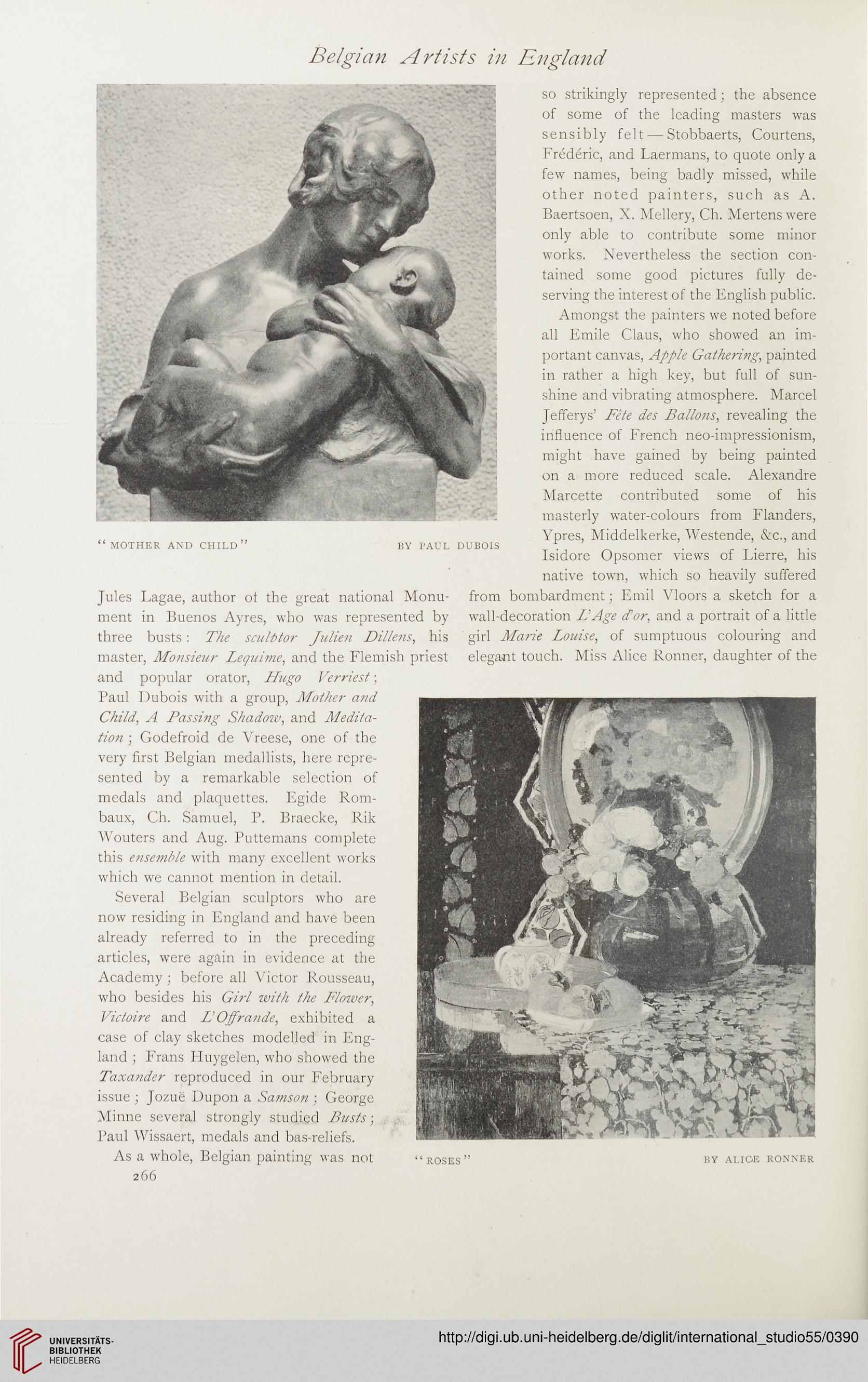Belgian Artists in England
“mother and child”
DUBOIS
BY PAUL
from
wall-decoration L’Age (for, and a portrait of a little
girl Marie Louise, of sumptuous colouring and
elegant touch. Miss Alice Ronner, daughter of the
“ roses”
so strikingly represented; the absence
of some of the leading masters was
sensibly felt — Stobbaerts, Courtens,
Frederic, and Laermans, to quote only a
few names, being badly missed, while
other noted painters, such as A.
Baertsoen, X. Mellery, Ch. Mertens were
only able to contribute some minor
works. Nevertheless the section con-
tained some good pictures fully de-
serving the interest of the English public.
Amongst the painters we noted before
all Emile Claus, who showed an im-
portant canvas, Apple Gathering, painted
in rather a high key, but full of sun-
shine and vibrating atmosphere. Marcel
Jefferys’ Fete des Ballons, revealing the
influence of French neo-impressionism,
might have gained by being painted
on a more reduced scale. Alexandre
Marcette contributed some of his
masterly water-colours from Flanders,
Ypres, Middelkerke, Westende, &c., and
Isidore Opsomer views of Lierre, his
native town, which so heavily suffered
bombardment; Emil Vloors a sketch for a
Jules Lagae, author of the great national Monu-
ment in Buenos Ayres, who was represented by
three busts: The sculhtor Julien Dillens, his
master, Monsieur Lequime, and the Flemish priest
and popular orator, Hugo Verriest;
Paul Dubois with a group, Mother and
Child, A Passing Shadow, and Medita-
tion \ Godefroid de Vreese, one of the
very first Belgian medallists, here repre-
sented by a remarkable selection of
medals and plaquettes. Egide Rom-
baux, Ch. Samuel, P. Braecke, Rik
Wouters and Aug. Puttemans complete
this ensemble with many excellent works
which we cannot mention in detail.
Several Belgian sculptors who are
now residing in England and have been
already referred to in the preceding
articles, were again in evidence at the
Academy; before all Victor Rousseau,
who besides his Girl with the Flozver,
Victoire and L? Offrande, exhibited a
case of clay sketches modelled in Eng-
land ; Frans Huygelen, who showed the
Taxander reproduced in our February
issue ; Jozue Dupon a Samson ; George
Minne several strongly studied Busts-,
Paul Wissaert, medals and bas-reliefs.
As a whole, Belgian painting was not
266
“mother and child”
DUBOIS
BY PAUL
from
wall-decoration L’Age (for, and a portrait of a little
girl Marie Louise, of sumptuous colouring and
elegant touch. Miss Alice Ronner, daughter of the
“ roses”
so strikingly represented; the absence
of some of the leading masters was
sensibly felt — Stobbaerts, Courtens,
Frederic, and Laermans, to quote only a
few names, being badly missed, while
other noted painters, such as A.
Baertsoen, X. Mellery, Ch. Mertens were
only able to contribute some minor
works. Nevertheless the section con-
tained some good pictures fully de-
serving the interest of the English public.
Amongst the painters we noted before
all Emile Claus, who showed an im-
portant canvas, Apple Gathering, painted
in rather a high key, but full of sun-
shine and vibrating atmosphere. Marcel
Jefferys’ Fete des Ballons, revealing the
influence of French neo-impressionism,
might have gained by being painted
on a more reduced scale. Alexandre
Marcette contributed some of his
masterly water-colours from Flanders,
Ypres, Middelkerke, Westende, &c., and
Isidore Opsomer views of Lierre, his
native town, which so heavily suffered
bombardment; Emil Vloors a sketch for a
Jules Lagae, author of the great national Monu-
ment in Buenos Ayres, who was represented by
three busts: The sculhtor Julien Dillens, his
master, Monsieur Lequime, and the Flemish priest
and popular orator, Hugo Verriest;
Paul Dubois with a group, Mother and
Child, A Passing Shadow, and Medita-
tion \ Godefroid de Vreese, one of the
very first Belgian medallists, here repre-
sented by a remarkable selection of
medals and plaquettes. Egide Rom-
baux, Ch. Samuel, P. Braecke, Rik
Wouters and Aug. Puttemans complete
this ensemble with many excellent works
which we cannot mention in detail.
Several Belgian sculptors who are
now residing in England and have been
already referred to in the preceding
articles, were again in evidence at the
Academy; before all Victor Rousseau,
who besides his Girl with the Flozver,
Victoire and L? Offrande, exhibited a
case of clay sketches modelled in Eng-
land ; Frans Huygelen, who showed the
Taxander reproduced in our February
issue ; Jozue Dupon a Samson ; George
Minne several strongly studied Busts-,
Paul Wissaert, medals and bas-reliefs.
As a whole, Belgian painting was not
266




